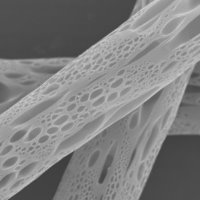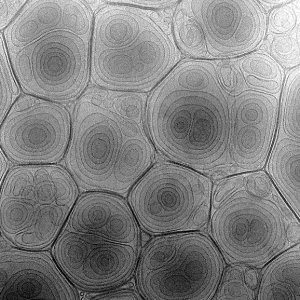|
|
| Structures and Phase Behaviors of Polymer |
| |
|
| Tuning the structures and phase behaviors of polymers is critical for obtaining desired material properties and for efficient applications of polymers. We develop strategies, equilibrium or nonequilibrium, to tailor the microstructures of polymers, with the goal of understanding and predicting microstructures on the basis of molecular architecture, kinetics and thermodynamics. We are currently working on the following subjects:
|
|
| 1. |
Controlling the molecular packing and chain orientation in conjugated polymers to achieve high optoelectronic performances of polymer-based devices. |
| 2. |
Manipulating the microstructures of block copolymers which are composed of two or more covalently end-linked homopolymers and can phase-separate into a variety of microdomains with long range order. |
| 3. |
Using electrospinning techniques to create nanofibers with controllable chain orientation and morphology. |
|
|
 |
 |
 |
|
|
| |
Microdomains of block copolymers |
Macroporous electrospun fibers |
Pentacene grown on nanofibers |
|
|
|
| |
|
|
| Self-Assembly of Amphiphiles |
| |
|
| Molecular self-assembly is the assembly of molecules without guidance or management from an outside source, which is an effective way to manipulate structures in nanoscale. In most cases, the molecules which can self-assemble are amphiphilic molecules (surfactants, lipids, block copolymers), with hydrophilic (water-loving) parts and hydrophobic (water-hating) parts. This class of molecules tend to form various structures, such as micelles and vesicles, in water as well as in organic solvents. We seek to obtain fundamental insight into the driving forces for self-assembly processes and further explore new types of self-assembled solutions and investigate the use of the biocompatible micelles, vesicles and gels for applications, such as drug delivery, controlled release, and templates for nanomaterials synthesis.
|
|
| |
|
 |
 |
|
|
| |
Jammed vesicles formed by lipids |
Vesicles formed by block copolymers |
|
|
| |
|
|
| |
|
| We use several tools to probe and characterize the microstructures present in the systems we study. Foremost among these are those used to probe the internal structures directly, including X-ray and Neutron scattering, atomic force microscopy (AFM), and electron microscopy (SEM and TEM). Rheology is the technique in which we have expertise used to study the flow properties of complex fluids. |
|
| |
|
|
Soft Nanomaterials Group | Last Updated February 20, 2021 |
